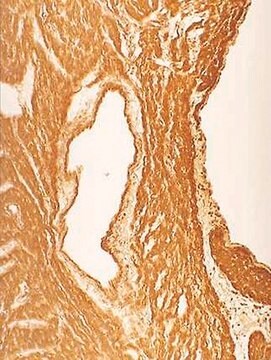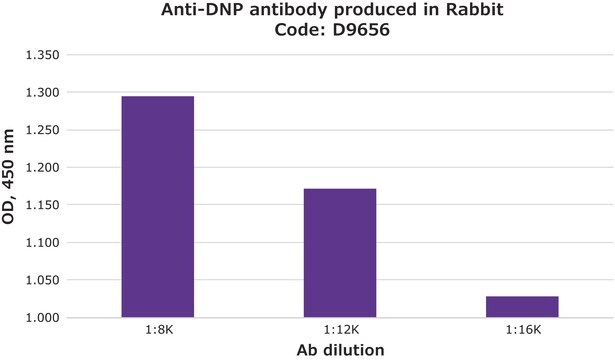AB5411
Anti-Nitrotyrosine Antibody
Chemicon®, from rabbit
About This Item
Prodotti consigliati
Origine biologica
rabbit
Livello qualitativo
Forma dell’anticorpo
purified immunoglobulin
Tipo di anticorpo
primary antibodies
Clone
polyclonal
Reattività contro le specie
mouse, human
Reattività contro le specie (prevista in base all’omologia)
all
Produttore/marchio commerciale
Chemicon®
tecniche
immunohistochemistry: suitable (paraffin)
western blot: suitable
Condizioni di spedizione
wet ice
modifica post-traduzionali bersaglio
unmodified
Informazioni sul gene
human ... NOS1(4842)
Descrizione generale
Specificità
Immunogeno
Applicazioni
Neuroscience
Oxidative Stress
1:100-1:1,000 dilution of a previous lot was used sucessfully in western blot when tested against nitrated BSA and nitrated ovalbumin.
Immunohistochemistry:
1:50-1:100 on paraffin embedded, 10% neutral buffer formalin fixed mouse liver (animal treated with Zymosan) and normal human cerebellum tissues. The tissues must be pretreated with heat induced epitope retrieval (HIER). Incubation with the AB5411 was for 10 minutes and the reaction was developed with the Chemicon IHCSelect, HRP-DAB kit (Catalog number DAB150).
Optimal working dilutions must be determined by end user.
Qualità
Nitrotyrosine (AB5411) staining of Mouse Brain (Zymosan), tissue pretreated with citrate buffer, pH 6.0. Polyclonal antibody was diluted to 1:500, using IHC-Select Detection with HRP-DAB. Immunoreactivity is seen in here in hippocampus.
Optimal Staining of Nitrotyrosine Monoclonal: Mouse Brain Treated With Zymosan.
Linkage
Stato fisico
Stoccaggio e stabilità
Risultati analitici
POSITIVE CONTROL: Tyrosine residues can be nitrated directly in situ on tissue sections using peroxynitrite (catalog # 20-107) to create a positive control. After the tissue section is deparaffinized, the slide is covered with a drop of PBS, pH 7.4 into which 10 microliters of peroxynitrite solution are mixed. Care should be taken that the solution maintains a pH of 7.4.
Altre note
Note legali
Esclusione di responsabilità
Non trovi il prodotto giusto?
Prova il nostro Motore di ricerca dei prodotti.
Codice della classe di stoccaggio
12 - Non Combustible Liquids
Classe di pericolosità dell'acqua (WGK)
WGK 2
Punto d’infiammabilità (°F)
Not applicable
Punto d’infiammabilità (°C)
Not applicable
Certificati d'analisi (COA)
Cerca il Certificati d'analisi (COA) digitando il numero di lotto/batch corrispondente. I numeri di lotto o di batch sono stampati sull'etichetta dei prodotti dopo la parola ‘Lotto’ o ‘Batch’.
Possiedi già questo prodotto?
I documenti relativi ai prodotti acquistati recentemente sono disponibili nell’Archivio dei documenti.
Il team dei nostri ricercatori vanta grande esperienza in tutte le aree della ricerca quali Life Science, scienza dei materiali, sintesi chimica, cromatografia, discipline analitiche, ecc..
Contatta l'Assistenza Tecnica.







